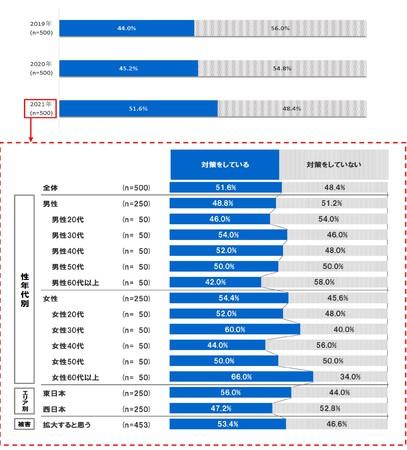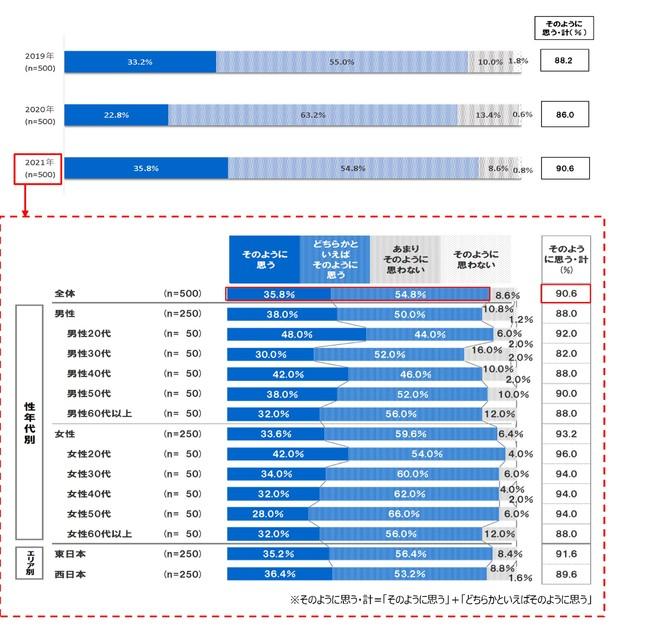-"Awareness survey on disaster prevention" -About half answered that they have not taken disaster prevention measures.
Japan is vulnerable to disasters such as earthquakes and tsunamis, and in recent years, due to the effects of climate change, natural disasters such as typhoons, torrential rains, and large-scale debris flows have caused enormous damage in various parts of the country. This year, the 10th survey, we focused on the differences in Japanese awareness and behavior regarding "disaster prevention" under these circumstances. ◆ All survey results can be downloaded from the following URL. Please use all means. URL: https://www.secom.co.jp/corporate/release/2021/pdf_DL/nr_20210818.pdf [Summary of survey results] ● For those who are concerned about the increase in disasters and the spread of damage in the future, the 2012 survey It exceeded 90% for the first time since the start. ● About half of the respondents answered that they did not take disaster prevention measures, at 48.4%. ● As for the disaster prevention measures taken, "daily stockpile of a certain amount of food and daily necessities (rolling stock)" was 67.4%, and "preparation of emergency carry-out bag" was 62.8%, which is more than 60%. ● 50% of the reasons for not taking disaster prevention measures are "I don't know what kind of measures should be taken". [Survey outline] ・ Survey period: July 9th to July 10th, 2021 ・ Survey target: 500 men and women nationwide (20-29 years old, 30-39 years old, 40-49 years old, 50-59 years old, 60 years old Above / 50 men and women each) ・ Survey method: Questionnaire response method via the Internet ■ Results of "Awareness Survey on Disaster Prevention" 1. The number of people concerned about the increase in disasters and the spread of damage in the future exceeded 90% for the first time since the survey started in 2012. Regarding the possibility of future disaster increase and damage expansion [Fig. 1], the total of "I think so (54.8%)" and "I think so (35.8%)" was 90.6%, which is a disaster. The percentage of people who are concerned about the increase in disasters and the spread of damage has exceeded 90% for the first time since the start of the survey in 2012. By gender, women in their twenties had the highest percentage at 96.0%, indicating a high level of awareness of crisis. Figure 1: Possibility of increasing disasters and expanding damage in the future (SA)
2. 2. About half of the respondents answered that they did not take disaster prevention measures, at 48.4%. In response to the question of whether disaster prevention measures are being taken [Fig. 2], 51.6% answered that they are taking measures, and although it exceeded 50% for the first time in this survey, 48.4% have not yet taken measures. I found out. By gender, women in their 60s and above (66.0%) had the highest number of respondents who answered that they were taking measures, while men in their 60s (42.0%) had the lowest results. Figure 2: Presence or absence of disaster prevention measures (SA) 3. As for the disaster prevention measures taken, "daily stockpile of a certain amount of food and daily necessities (rolling stock)" was 67.4%, and "preparation of emergency carry-out bag" was 62.8%, which is more than 60%. What kind of measures are being taken for those who are taking some kind of disaster prevention measures? [Fig. 3] When asked, No. 1 "Daily stockpile of a certain amount of food and daily necessities (rolling stock) (67.4%)", 2nd place "Preparation of emergency carry-out bag (62.8%)" and preparation of stockpile exceeded 60%. On the other hand, information gathering and equipment in case of a disaster, such as "confirming dangerous areas and evacuation areas on hazard maps (42.2%)" and "installing fall prevention equipment on TVs and cupboards (37.2%)". It turned out that less than half of the people are taking measures to introduce. Figure 3: What kind of disaster prevention measures are you taking (MA) 4. 50% of the reasons for not taking disaster prevention measures are "I don't know what kind of measures should be taken". When I asked people who did not take disaster prevention measures for the reason [Fig. 4], the 1st place was "I don't know what kind of measures should be taken (50.8%)" and the 2nd place was "In the area where I live". "Because almost no disasters occur (29.3%)", 3rd place "Because the procedures and preparations for countermeasures are troublesome (25.6%)". It can be read that awareness of disaster prevention measures will increase by knowing specific measures and having a sense of ownership. Figure 4: Reasons for not taking disaster prevention measures (MA) << Recommended services of SECOM in case of emergency >> ■ "SECOM Super Rescue" The "final version" of the disaster prevention equipment set prepared by SECOM. Two types are available: "Standard", which is a standardization of carefully selected items with high practicality, and "Plus", which pursues further functionality, such as adding a simple air mattress to a high-performance item for winter clothing. I am.

■ "Anshin Disaster Prevention Shelter" A shelter to protect yourself from disasters such as earthquakes, tsunamis, landslides, and floods. The main body is made of impact-resistant fiber reinforced plastic (FRP) and has a structure that can withstand a load of 30 tons. The inside is a closed structure to ensure waterproofness, and it is equipped with an "automatic swing structure" in which the hatch faces upward when floating on water. You can use a mobile phone or GPS from the inside, and you can use the optional location information system "Kokosecom" to identify the location and request rescue arrangements. As accessories, we also have disaster supplies such as helmets, life jackets, preserved water and food.
■ Portable storage battery A storage battery that can supply power to TVs, PCs, smartphones, etc., which are necessary for collecting information and securing communication means in the event of a power outage. The built-in large lithium-ion battery is produced domestically. It has passed rigorous tests such as vibration test and impact test, and has safety that does not ignite even if it is crushed or overcharged.